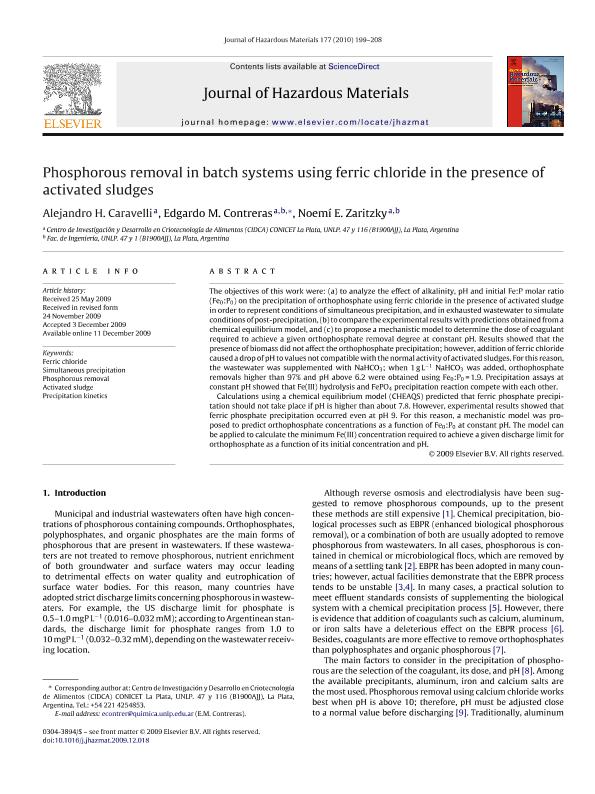Mostrar el registro sencillo del ítem
dc.contributor.author
Caravelli, Alejandro Horacio

dc.contributor.author
Contreras, Edgardo Martin

dc.contributor.author
Zaritzky, Noemi Elisabet

dc.date.available
2017-08-25T18:34:39Z
dc.date.issued
2010-05-11
dc.identifier.citation
Caravelli, Alejandro Horacio; Contreras, Edgardo Martin; Zaritzky, Noemi Elisabet; Phosphorous removal in batch systems using ferric chloride in the presence of activated sludges; Elsevier Science; Journal of Hazardous Materials; 177; 1-3; 11-5-2010; 199-208
dc.identifier.issn
0304-3894
dc.identifier.uri
http://hdl.handle.net/11336/23005
dc.description.abstract
The objectives of this work were: (a) to analyze the effect of alkalinity, pH and initial Fe:P molar ratio (Fe0:P0) on the precipitation of orthophosphate using ferric chloride in the presence of activated sludge in order to represent conditions of simultaneous precipitation, and in exhausted wastewater to simulate conditions of post-precipitation, (b) to compare the experimental results with predictions obtained from a chemical equilibrium model, and (c) to propose a mechanistic model to determine the dose of coagulant required to achieve a given orthophosphate removal degree at constant pH. Results showed that the presence of biomass did not affect the orthophosphate precipitation; however, addition of ferric chloride caused a drop of pH to values not compatible with the normal activity of activated sludges. For this reason, the wastewater was supplemented with NaHCO3; when 1gL-1 NaHCO3 was added, orthophosphate removals higher than 97% and pH above 6.2 were obtained using Fe0:P0=1.9. Precipitation assays at constant pH showed that Fe(III) hydrolysis and FePO4 precipitation reaction compete with each other.Calculations using a chemical equilibrium model (CHEAQS) predicted that ferric phosphate precipitation should not take place if pH is higher than about 7.8. However, experimental results showed that ferric phosphate precipitation occurred even at pH 9. For this reason, a mechanistic model was proposed to predict orthophosphate concentrations as a function of Fe0:P0 at constant pH. The model can be applied to calculate the minimum Fe(III) concentration required to achieve a given discharge limit for orthophosphate as a function of its initial concentration and pH.
dc.format
application/pdf
dc.language.iso
eng
dc.publisher
Elsevier Science

dc.rights
info:eu-repo/semantics/openAccess
dc.rights.uri
https://creativecommons.org/licenses/by-nc-sa/2.5/ar/
dc.subject
Activated Sludge
dc.subject
Ferric Chloride
dc.subject
Phosphorous Removal
dc.subject
Precipitation Kinetics
dc.subject
Simultaneous Precipitation
dc.subject.classification
Físico-Química, Ciencia de los Polímeros, Electroquímica

dc.subject.classification
Ciencias Químicas

dc.subject.classification
CIENCIAS NATURALES Y EXACTAS

dc.subject.classification
Ingeniería Oceanográfica

dc.subject.classification
Ingeniería del Medio Ambiente

dc.subject.classification
INGENIERÍAS Y TECNOLOGÍAS

dc.title
Phosphorous removal in batch systems using ferric chloride in the presence of activated sludges
dc.type
info:eu-repo/semantics/article
dc.type
info:ar-repo/semantics/artículo
dc.type
info:eu-repo/semantics/publishedVersion
dc.date.updated
2017-05-09T19:37:30Z
dc.journal.volume
177
dc.journal.number
1-3
dc.journal.pagination
199-208
dc.journal.pais
Países Bajos

dc.journal.ciudad
Amsterdam
dc.description.fil
Fil: Caravelli, Alejandro Horacio. Provincia de Buenos Aires. Gobernación. Comisión de Investigaciones Científicas. Centro de Investigación y Desarrollo en Criotecnología de Alimentos. Consejo Nacional de Investigaciones Científicas y Técnicas. Centro Científico Tecnológico Conicet - La Plata. Centro de Investigación y Desarrollo en Criotecnología de Alimentos. Universidad Nacional de la Plata. Facultad de Ciencias Exactas. Centro de Investigación y Desarrollo en Criotecnología de Alimentos; Argentina
dc.description.fil
Fil: Contreras, Edgardo Martin. Provincia de Buenos Aires. Gobernación. Comisión de Investigaciones Científicas. Centro de Investigación y Desarrollo en Criotecnología de Alimentos. Consejo Nacional de Investigaciones Científicas y Técnicas. Centro Científico Tecnológico Conicet - La Plata. Centro de Investigación y Desarrollo en Criotecnología de Alimentos. Universidad Nacional de la Plata. Facultad de Ciencias Exactas. Centro de Investigación y Desarrollo en Criotecnología de Alimentos; Argentina. Universidad Nacional de La Plata. Facultad de Ingeniería; Argentina
dc.description.fil
Fil: Zaritzky, Noemi Elisabet. Universidad Nacional de La Plata. Facultad de Ingeniería; Argentina. Provincia de Buenos Aires. Gobernación. Comisión de Investigaciones Científicas. Centro de Investigación y Desarrollo en Criotecnología de Alimentos. Consejo Nacional de Investigaciones Científicas y Técnicas. Centro Científico Tecnológico Conicet - La Plata. Centro de Investigación y Desarrollo en Criotecnología de Alimentos. Universidad Nacional de la Plata. Facultad de Ciencias Exactas. Centro de Investigación y Desarrollo en Criotecnología de Alimentos; Argentina
dc.journal.title
Journal of Hazardous Materials

dc.relation.alternativeid
info:eu-repo/semantics/altIdentifier/url/http://www.sciencedirect.com/science/article/pii/S030438940901989X
dc.relation.alternativeid
info:eu-repo/semantics/altIdentifier/doi/http://dx.doi.org/10.1016/j.jhazmat.2009.12.018
Archivos asociados
